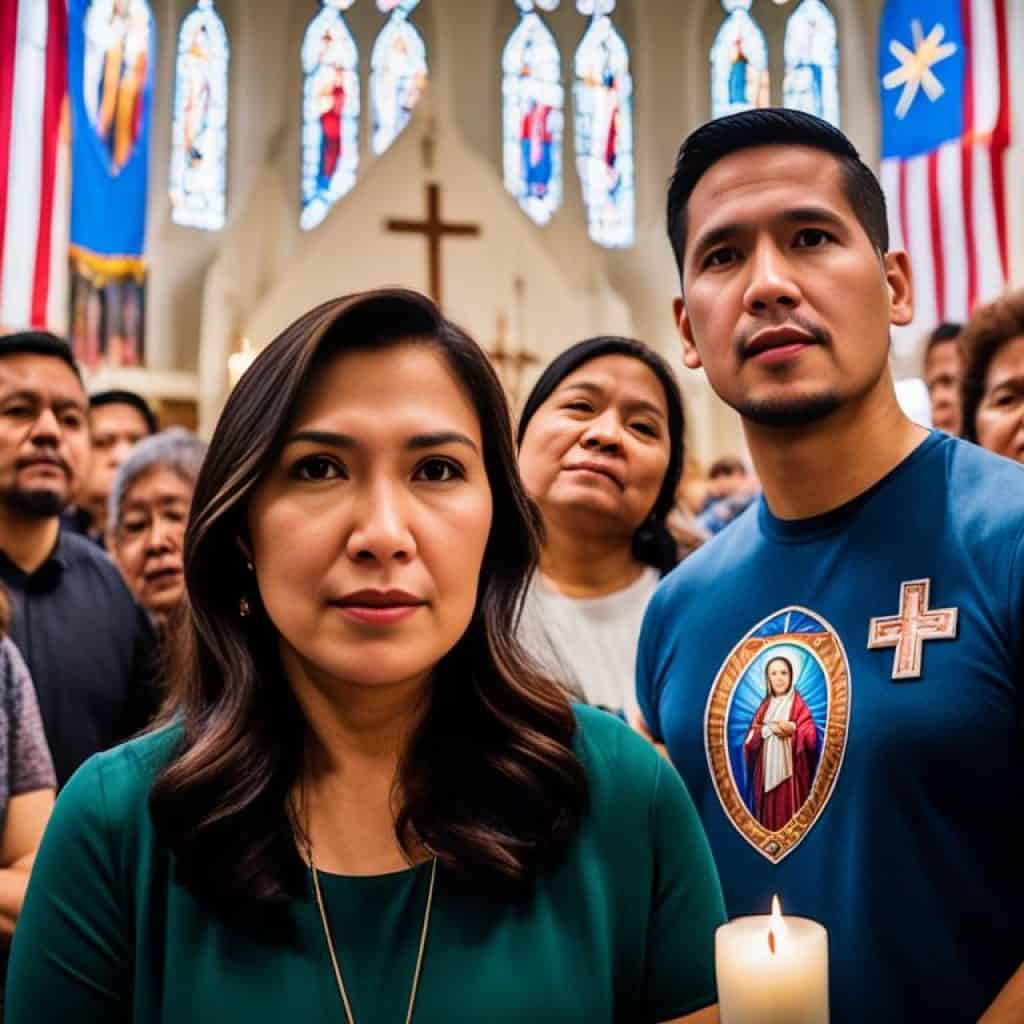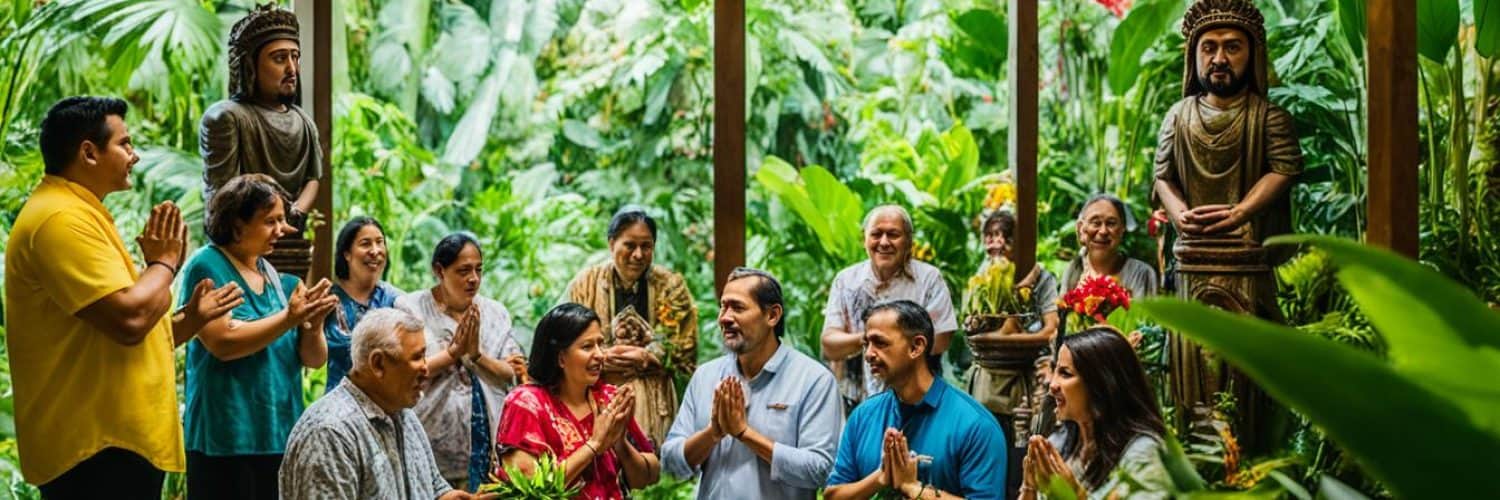The Philippines stands out for how it mixes faith and culture together. It is known for its deep Catholic roots, with more than 81% of people following this faith1. The country combines Christian teachings with traditional beliefs from before the Spanish arrived. This mix creates a unique and strong Christian identity in the Philippines.
This article is a journey into Filipino Christian culture. We will see how faith and tradition have stayed together over time. We’ll cover the history from the 16th century until now. It shows the lasting power of their spiritual history.
Key Takeaways
- The Philippines is a predominantly Catholic country, with over 81% of the population identifying as such1.
- The integration of Catholic beliefs and practices with pre-colonial animistic traditions has resulted in a unique and vibrant Filipino Christian faith.
- The harmony of faith and culture has been preserved and celebrated over the centuries, shaping the rich tapestry of Filipino Christian identity.
- The Filipino Christian community has played a crucial role in fostering interfaith harmony and dialogue within the country.
- The Catholic Church has had a significant influence on the social and cultural fabric of Filipino society, advocating for social justice and human rights.
The Foundations of Filipino Christian Faith
In the 16th century, Spanish missionaries came to the Philippines and shared Catholicism.2 They were Augustinians, Franciscans, and Jesuits. They quickly converted many locals. Yet, merging Catholicism with the native beliefs wasn’t easy.
The Arrival of Spanish Missionaries
Before the Spaniards came, the Filipinos practiced animism. This meant they believed in spirits in nature.2 The missionaries introduced Catholicism. But, the people found ways to mix their old and new beliefs.
The Spread of Catholicism in the Philippines
This blending made for a rich Filipino Christian identity later on.2 The goal is for the Philippines to improve its status globally. Universities play a big part in this by teaching and involving the community.
They focus on building good character. This is seen as key to a strong nation, helping address moral issues in the society.
Pre-Colonial Animistic Beliefs and Practices
The Filipino Christian Living Program teaches Catholicism and encourages prayer and church involvement.2 It blends Filipino culture with the teachings of the Bible.
Preserving Traditional Family Values
The Filipino Christian community is all about traditional filipino christian family values. These values are key to their culture for a long time.3 Yet, moving to new places and fitting into modern life make it hard. Many filipino immigrants struggle to keep up with the old customs like family unity and respect for elders.3 They also find it tough to pass on their faith to the next generation.3
Maintaining Family Integrity Amidst Migration
Church groups and local parishes are stepping up. They offer family enrichment programs to help filipino parents raise kids with a strong faith.3 Even with the challenges, the filipino christian community sticks to its goals.3 They see these traditional family values as vital to their cultural and spiritual identity.3
Raising Youth in the Filipino Christian Tradition
The filipino christian community knows involving the young is crucial. This is because growing up in cities or abroad exposes kids to many ideas. This often leads them to focus only on themselves.3 So, they have set up programs to help filipino parents and to involve filipino youth in their faith through activities and teachings that fit their culture.3 This way, they strive to face today’s challenges while keeping their faith and cultural identity strong.3
Integrating Folk Religiosity
In the Philippines, the Christian faith is closely linked with old folk beliefs. This connection comes from merging Catholicism with the traditions of native groups before the Spanish arrived.1 As a result, a unique type of devotion, known as Filipino Folk Catholicism, has developed. It blends practices like honoring saints and celebrating fiestas with old cultural beliefs. Icons and imagery in religious practices also reflect this mix.1
Many scholars say that Catholicism was easily accepted in the Philippines. They believe this is because it matched many native beliefs about gods and spirits.1 So, Filipinos felt a strong bond to their past while joining the new faith.
Folk Catholicism: Rituals and Traditions
The way Filipino Folk Catholicism celebrates saints and traditions is special. During saint veneration, there are hints of ancient spirits mixed with modern Christian devotions.4 Fiestas, large community celebrations, also mix local and Catholic elements. These parties include religious processions, artistic displays, and entertainment.4
When it comes to worship, Filipino Christians use unique designs in their religious art. These designs add the local culture into the Catholic visuals used in prayer and church decoration.
Syncretism: Blending Indigenous Beliefs with Christianity
The blending of native and Catholic beliefs is a key part of Filipino Christianity. This blending allowed people to keep close to their roots while introducing them to the Catholic faith.1 Thus, Filipino Christianity is diverse and dynamic.
Religious festivals, daily religious practices, and the way cultural beliefs mix with Catholicism show this ongoing process.4 It’s this blending that makes the Philippines’ version of Christianity unique.
Filipino Christian Communities in the US
Filipino immigrants in the United States have built vibrant5 Christian communities. These places help keep their cultural traditions alive. Across America, many dioceses and parishes have special groups just for Filipino Catholics.
Establishing Filipino Catholic Organizations
These groups offer ways for Filipinos to celebrate their faith in their own style.5 They also help create a strong sense of community and welcome5. Through cultural festivals, youth activities, and faith support, they’ve kept their heritage alive. This has helped them face the challenges of starting anew in the US.
Preserving Cultural Identity through Faith
Connecting deeply with their Christian faith has helped Filipinos maintain their culture5. This effort is key in growing the Filipinotown community in Los Angeles5.

The Dynamics of Filipino Christian Identity
The Filipino Christian identity is rich and varied, blending faith and culture for centuries. When Spanish missionaries brought6 Catholicism to the islands, it mixed with native beliefs. This created a special form of Christianity only found in the Philippines. This mix helps Filipinos keep their cultural roots while following the Catholic faith. It makes their religious identity colorful and deep.7 This identity grows from the talks between the Church’s main teachings and local religious practices. It also faces the changes brought by modern life.8 In the end, the Filipino Christian identity shows the creativity and strength of its people. They have combined old traditions with new beliefs, making a unique and thriving spiritual tradition.
The journey to find the dynamics of Filipino Christian identity has made some feel they don’t fully fit in some Christian groups. This struggle and a quest to fit in are part of the Filipino Christian experience.7 Filipino Christians also face issues like who they include, the place of evangelicalism, and how race plays a part in Christian life.8 Even with these tests, the Filipino Christian identity remains strong. The community works through modern issues while holding onto its deep cultural and spiritual roots.
The intersection of faith and culture in the Philippines creates a special Filipino Christian identity. It mixes old beliefs with new ones beautifully.6 This identity values family, community, and nature. It’s committed to keeping cultural traditions alive.7 The Filipino Christian cultural identity is shaped by conversations between the Church’s formal teachings and local spiritual customs. This dialogue adds depth and variety to their spiritual life.8 Filipinos have shown their strength and creativity by blending their old ways with today’s beliefs. It’s how they’ve built a spiritual identity that’s rich and balanced.
Fostering Interfaith Harmony
The Filipino Christian community works hard to bring different faiths together in peace9. They celebrate the World Interfaith Harmony Week each year. This event joins people from all beliefs to understand each other better and work together10. Catholic, Protestant, Muslim, Hindu, and Buddhist leaders gather to honor their shared beliefs10. They focus on love, compassion, and caring for nature. This open-hearted sharing shows how Christian Filipinos learn from and work with other faiths9. They know that having many beliefs makes society better. By talking and working together, they help create peace and respect at home.
Celebrating World Interfaith Harmony Week
In the Philippines, the World Interfaith Harmony Week is a big deal10. It’s widely observed in over 40 countries thanks to a UN decision. The Philippines has warmly welcomed it10. Events in Zamboanga City and Manila, hosted by different faiths, have been key10. They get leaders and followers from various religions to share common values. They find ways to better understand and unite with each other.
Promoting Mutual Understanding and Dialogue
The effort for interfaith harmony in the Philippines goes beyond just one week10. There’s a proposed bill for World Interfaith Harmony in the Philippines. It aims to enhance understanding among different faiths10. Also, The Church of Jesus Christ of Latter-day Saints upholds freedom and respect for all beliefs10. It organizes talks between religious leaders. They aim to grow harmony and peaceful living together10. A forum in Quezon City, led by former Senator Santanina T. Rasul, called for peace among Catholics, Muslims, Buddhists, and others10. These steps reflect the Filipino Christian community’s effort to boost understanding, respect, and cooperation among various faiths.
Environmental Stewardship in Filipino Christianity
The Filipino Christian tradition strongly believes in caring for the environment.11 They follow Catholic teachings about the earth’s sacredness and living sustainably. This has led to a deep respect for the land and efforts to protect it.11
Teachings on God’s Creation
Many places in the Philippines work to raise awareness about environmental issues.11 They say the Christian community has a big role in fighting the climate crisis. By being good stewards, they show they want to keep the earth beautiful and healthy.11
Sustainable Living and Eco-Friendly Practices
12 Because the Philippines often faces natural disasters, Christians there do a lot to live green. They have big campaigns and even eat less meat to help the planet.12 They also have a special time every year, from September 1st to October 4th, to focus on taking care of God’s gifts.12
The Filipino Christian community is devoted to helping the environment in many ways. They deeply respect nature and feel everyone should help protect it. Their work shows their strong commitment to saving the earth and living in ways that keep it safe.
Filipino christian
The phrase “Filipino Christian” shows a rare mix of Catholic beliefs and local cultural practices. It’s how most Filipinos live their faith. Owing to the country being mainly Catholic, the Philippines has a history filled with blending Christian and native customs. This mix has made the Filipino Christian identity very diverse and lively. Here, old traditions exist peacefully with the beliefs of the Catholic Church.13
Filipino Christians deeply value their families, communities, and the environment. They also work hard to keep their cultural legacies and practices alive. This fusion of faith and culture has stayed strong across centuries, even with changes and outside influences. It truly reflects the spiritual face of the Filipino people.

| Religious Affiliation in the Philippines (2020) | Percentage of Population |
|---|---|
| Roman Catholicism | 78.8%14 |
| Islam | 6.4%14 |
| Iglesia ni Cristo | 2.6%14 |
| Philippine Independent Church | 1.4%14 |
| Seventh-day Adventist Church | 1.3%14 |
| Other Christian Denominations | 3.8%14 |
| Other Faiths and No Affiliation | 5.7%14 |
| Indigenous Philippine Folk Religions (Anitism) | 2%14 |
| Evangelicals | 2%14 |
The Role of the Church in Filipino Society
The Catholic Church deeply impacts Filipino society. It is the main religious body in the nation.15 This gives it great power to shape people’s values, customs, and even their take on big societal issues.15 The Church is key in preserving Filipino culture, from its old churches to its religious events.
Social and Cultural Influence
The Catholic Church’s reach extends into education and politics in the Philippines.15 By the 1930s, most of the graduates from Philippine universities were under the Church’s umbrella.15 Also, the majority of politicians in the country were Catholic,15 which shows the Church’s deep integration into society.
Advocating for Social Justice and Human Rights
The Church also stands for social justice and human rights. In 1981, thousands of priests and nuns protested against a corrupt election.15 They showed their support for fair elections by helping half a million volunteers to monitor the polls.15 The Church’s involvement was crucial in the People Power movement that led to Corazon Aquino’s win in 1986.15
This multi-faceted work makes the Church a central element of Philippine life. It influences the culture, social structure, and politics of the nation.15 Its push for justice, human rights, and caring for the environment strengthens its role in nurturing the country’s moral and ethical roots.
Celebrating Filipino Christian Traditions
Filipino Christian traditions are full of life and color.13 They show the deep connection between faith and culture.13 Fiestas and religious festivals are at the heart of these celebrations. They honor patron saints and mix Catholic practices with local customs. This mix includes parades, music, and dances.
Fiestas and Religious Festivals
These celebrations are more than just events. They bring together the past and present of the Philippines.13 The use of local music and dances in Christian worship shows the strong link between culture and faith. Each celebration is a beautiful mix of old and new, making them truly unforgettable.16 They not only celebrate faith but also connect families and communities. Plus, they keep the Filipino culture alive for future generations.
Music and Dance in Filipino Christian Worship
The festivities in the Philippines are all about unity – uniting faith with cultural roots.1316 Using local music and dance in religious practices sets their celebrations apart. They’re not just about worship; they’re also a vibrant display of what makes the Philippines special. These traditions are loved by Filipinos and visitors alike, uniting people through their unique heritage.
Challenges and Opportunities
The Filipino Christian community has a deep cultural and spiritual background. Yet, it faces hurdles in today’s fast-changing world.17 Migration and urbanization, along with global trends, can weaken traditional family ties. They also make it harder to pass on faith to the young. Filipino Christian youth sometimes feel torn between their family’s beliefs and modern culture. This can lead to a struggle in finding their own path and sense of belonging.18
Adapting to Modern Society
Despite the obstacles, challenges are seen as chances for growth and change in the community.19 Programs are put in place to help parents be better at guiding their children in faith. Youth are involved in activities that speak to their cultural roots. This makes sure that while keeping traditions, they can still adapt to the world around them. This balance helps the Filipino Christian community keep its faith and cultural spark alive.
Engaging the Youth in Faith Formation
18 Not all Filipino American youth get the support they need because of certain assumptions. People often think they are doing well in health, school, and social life. So, their needs might be overlooked. However, seeing past this, efforts are made to connect the youth with their faith. These aim to create a sense of community and identity in line with Christian values.
Parents play a key role in guiding their children’s faith, while the youth are engaged in activities that speak to their cultural heritage. This approach helps the community tackle modern challenges. It also safeguards the beauty of its traditions and values.171918
The History of Christianity in the Philippines
The Christian story of the Philippines is deeply connected to its history with foreign powers. Spanish missionaries first arrived in the 16th century. They began the long-term presence of the Catholic Church in the islands.20 Over three hundred years, the Catholic faith became rooted in the country. The Augustinians, Franciscans, and Jesuits were key in converting the locals.20 During this time, the Filipinos merged their traditional beliefs with Catholicism. This mix gave birth to a unique Filipino Folk Catholicism.
The Spanish Colonial Era
20 The story of Christianity in the Philippines dates back to 1521. This is when Ferdinand Magellan visited Cebu Island. After his visit, more than 2,000 Cebu residents turned to Christianity.
From 1565 to the end of the Spanish rule three centuries later, the Catholic faith grew. The Church sent groups like the Augustinians and Jesuits to spread the faith.20 Manila, the hub of Spanish power, became a bustling center for this effort.
The American Period and Protestant Influence
After the Spanish, the American era brought a new wave of Christian missionaries. This further diversified the Philippines’ religious scene.21 By the early 1900s, about one-fourth of the people had joined Christianity. Among many efforts, the publication of the “Doctrina Christiana” helped spread the faith. This book was printed in both Tagalog and Spanish.
Books in various Filipino languages, including educational texts, were made from the 1600s to 1800s. They helped teach Christianity and local languages.21 The resistance to Spanish rule grew with time. Leaders like José Rizal, who wrote “Noli me tángere” and “El filibusterismo,” fought against the Spanish. Rizal’s work made him a hero in the Philippines.
While Catholicism was the main faith, Protestants also gained followers. Ongoing folk beliefs mixed with Protestant ideas. This mix changed how Filipinos practiced Christianity, making it uniquely their own.
Filipino Christian Art and Architecture
The artwork and buildings from the Filipino Christian tradition show a mix of native and Catholic styles.22 Churches from the colonial era blend European looks with local touches. This mix shows the deep Christian roots in the country, highlighting local creative twists.
Colonial Churches and Cathedrals
In Filipino Christian art, images of saints and the Virgin Mary often include local touches, like bold colors and local plants.23 These pieces show deep faith. They also celebrate the unique Filipino Christian culture.
Religious Imagery and Iconography
An ivory sculpture of Christ’s crucifixion dates back to the late 1500s. It was likely brought to Manila from India.24 Filipino artists learned this from Chinese teachers, mixing different styles.
This artwork then traveled through the Manila galleon trade, reaching places like Mexico and Europe. This shows the Philippines’ important link in a global trade network, moving art across the world.
Filipino Christian Literature and Poetry
The Filipino Christian tradition has left a lasting impact on the country’s literary scene. For many generations, Filipino writers and poets drew inspiration from their faith and cultural heritage. They explored themes like spirituality, identity, and the human experience, viewing it through a Filipino Christian lens.25
Early Catholic missionaries penned devotional works, and modern Filipino Christian authors and poets continue this legacy. Their works reflect the changing face of the Filipino Christian identity. They often tackle the challenge of blending faith and culture, celebrating the Filipino people’s spiritual richness.25
Filipino Christian writers and poets have helped keep their community’s unique stories alive. They have shared different viewpoints and artistic forms. This ensures the rich legacy of Filipino Christianity keeps touching and inspiring readers, both locally and globally.25
| Title | Publication Year | Subject Matter |
|---|---|---|
| “La Immaculada a traves de los siglos corona poetica que a su excelsa : patrona Maria Immaculada en el cincuentinario de su definicion dogmatica dedica el Ateneo de Manila” | 1904 | Religious poetry |
| “The Penguin book of religious verse” | 1963 | Religious verse |
| “Life of Jesus in verse” | 1987 | Religious poetry |
| “A heart for Jesus : inspirational poems” | 2001 | Inspirational poetry |
Back in 1593, the “Doctrina Christiana” became one of the first European books in the Philippines. It shows Catholic beliefs mixed with the local Tagalog, written in Romanized and Baybayin scripts. This early blend anticipates the cultural mix that would define Filipino Christian literature in the following years.26
Conclusion
The Filipino Christian identity is a mix of Catholic beliefs and Filipino culture.27 This mix creates a strong and colorful Christianity. It has stood the test of time, facing challenges like colonialism and modern issues.
Since Spanish missionaries came in the 16th century, Filipinos have made Christianity their own.28 They blended their old ways with what the Church taught. This made a spiritual tradition that’s closely tied to family and community.
Now, as the Philippines marks 500 years of Christianity, the Filipino Christian identity is still growing.27 It faces new chances and challenges today. But, faith, family, and keeping their culture strong are still key. This shows how strong the Filipinos’ spiritual culture is. By keeping their unique Christian ways, they are ready for the future.
FAQ
What is the significance of Christianity in the Philippines?
How did the pre-existing animistic beliefs of the Philippines influence the development of Filipino Christianity?
How do traditional Filipino family values shape the Filipino Christian experience?
What is the role of folk religiosity in Filipino Christianity?
How have Filipino Christians in the United States maintained their cultural identity and traditions?
How has the Filipino Christian community engaged in interfaith dialogue and harmony?
What is the Filipino Christian tradition’s approach to environmental stewardship?
What is the significance of the term “Filipino Christian”?
What is the role of the Catholic Church in shaping Filipino society?
How do Filipinos celebrate their Christian traditions?
Source Links
- https://www.mdpi.com/2077-1444/12/10/800
- https://www.studocu.com/ph/document/university-of-perpetual-help-system-dalta/the-perpetualite-identity-and-dignity/fcl-1-midterm-reviewer-this-is-for-the-subject-filipino-christian-living-fcl-i-have-other-fcl-notes/27835877
- https://mariaisquixotic.com/modern-challenges-filipino-families/
- https://journals.upd.edu.ph/index.php/Banwaan/article/download/8554/7491/
- https://www.nps.gov/places/filipino-christian-church.htm
- https://caac.ptsem.edu/do-you-hate-being-filipino/
- https://omf.org/the-gospel-in-the-filipino-context-jose-m-de-mesa-and-melba-p-maggay/
- https://typeset.io/questions/how-do-christian-values-influence-the-way-that-filipinos-1kle4mp0mw
- https://www.linkedin.com/pulse/what-best-pathway-achieve-inter-faith-harmony-unity-mirza-zia-hussain-uyovf
- https://news-ph.churchofjesuschrist.org/article/strengthening-interfaith-dialogues-and-understanding-in-the-philippines
- https://www.mdpi.com/2077-1444/13/1/56
- https://www.ncronline.org/blogs/world/eco-catholic/philippine-church-takes-lead-francis-environmental-encyclical
- https://en.wikipedia.org/wiki/Christianity_in_the_Philippines
- https://en.wikipedia.org/wiki/Religion_in_the_Philippines
- https://rpl.hds.harvard.edu/faq/catholicism-philippines
- https://soc2273.weebly.com/customs-and-traditions.html
- https://www.cicm-mission.org/index.php/en/our-family/our-dear-departed/44-reflections/157-five-hundred-years-of-christianity-in-the-philippines-some-critical-issues-and-challenges-for-today-s-missionaries
- https://jyd.pitt.edu/ojs/jyd/article/view/19-14-02-FA-07/819
- https://www.churchinneed.org/despite-challenges-the-church-in-the-philippines-is-joyous-and-dynamic/
- https://drivethruhistory.com/christian-history-of-the-philippines/
- https://blogs.loc.gov/international-collections/2018/07/catholicism-in-the-philippines-during-the-spanish-colonial-period-1521-1898/
- https://en.wikipedia.org/wiki/Architecture_of_the_Philippines
- https://www.elib.gov.ph/results.php?f=subject&q=Christian art and symbolism
- https://smarthistory.org/christ-crucified/
- https://www.elib.gov.ph/results.php?f=subject&q=Religious poetry
- https://blogs.loc.gov/international-collections/2019/10/doctrina-christiana-more-than-four-hundred-years-of-filipino-american-history/
- https://www.9marks.org/article/churches-in-the-philippines-taking-seriously-the-joy-of-the-lord/
- https://www.ncbi.nlm.nih.gov/pmc/articles/PMC7989222/







Add comment